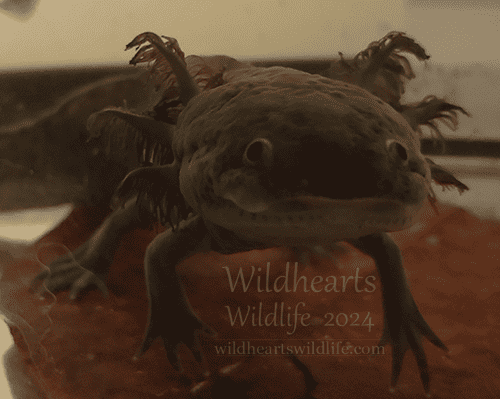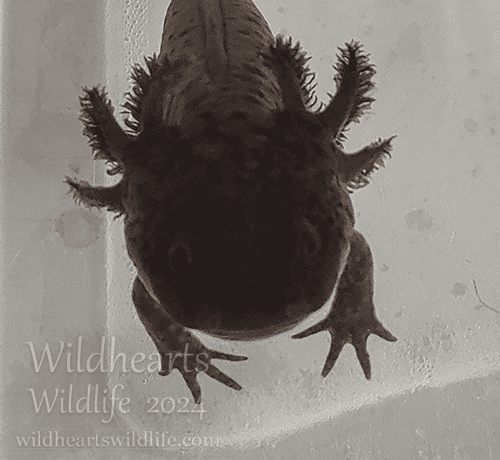I currently care for 4 axolotls – Bubbles, Locke, Gilly, and Nova! As you can imagine, more axolotls can mean more aquariums and more aquariums means more work – cycling tanks, water changes, temperature and parameter monitoring, etc. Since I started this site and posted quite a few articles about axolotls, I often get messages asking questions about our neonatic friends.
One of the questions I’ve received over and over again is whether or not axolotls can be housed together. And I can’t say I blame anyone for wanting more than one! Axolotls are derpily adorable, adorpable if you will, and they come in quite few different color morphs. Hey, and I have 4! If you’re looking for someone to tell you to be responsible and just get one maybe I’m not the gal for the job? Or maybe this is a “do as I say not as I do” type situation?
But if you’re like me and just one adorpable little aquatic friend just doesn’t feel like enough for you, then keeping more than one axolotl in a single aquarium might sound like a good idea. You get to double the axolotl goodness without doubling your number of aquariums? Is it too good to be true? Is it safe to house multiple axolotls together?
Do Axolotls Actually Like Living With Other Axolotls?
I kind of hate to be the one to tell you, but axolotls are not a social species. People on the internet will sometimes tell you otherwise, likely due to the fact that axolotls kept together will sometimes appear to ‘snuggle’ or spend a lot of time together. In the wild, axolotls don’t seek out others of their kind for companionship. They only seek out other axolotls to breed.
If two axolotls are seen together, it’s typically just a coincidence. In home aquariums it’s likely that two axolotls in the same tank who appear to be hanging out together in actuality just both enjoy the same area of their home. This may be due to factors such as water flow, light levels, or other tank conditions that make certain spots in the aquarium more desirable hang out spots.
Let’s be honest here. If you already own an axolotl you have probably already noticed that they’re really not the brightest animals. Quite the opposite, in fact. It’s ok! Their lack of intelligence is part of their charm. But it does mean, sorry axolotls, that they don’t really have the brain capacity to develop strong friendship bonds with other axolotls.
OK, But Is Keeping Them Together Dangerous?
Sometimes. But not always.
I know, that type of answer sucks.

So here’s the deal. Young axolotls go through a cannibalistic stage. During this stage, they’re much more likely to harm each other. Young axolotls will often nip and bite at each other, sometimes even causing serious injuries such as loss of limbs and, in some cases, death.
Typically, but not always, axolotls will grow out of this extreme cannibalistic stage by the time they reach adulthood. Ok, cool, so does that mean adult axolotls can be kept together!? Sometimes. But not always!
You should only think about attempting to keep adult axolotls together if they are a very similar size. It’s dangerous to keep a large axolotl together with a smaller one. More likely than not, the smaller one will get bullied and can be severely injured.
You should never keep male and female axolotls together. The males can get quite persistent when it comes to pursuing the ladies, which, long term, can lead to a lot of stress for the females. Over breeding depletes the females’ bodies and can lower their immune systems. If females are not outright killed, eventually, by over-eager males they will typically live shortened lifespans due to constant stress and over-breeding.
Housing Multiple Axolotls Together Is Risky

In my probably not-so-humble opinion, housing multiple axolotls together always carries a risk. Even if you end up with two adult axolotls that are a similar size and the same gender, there’s no guarantee that they won’t hurt each other. I can’t tell you how many times I’ve talked to owners who told me their axolotls lived together, seemingly happily, for years before one randomly decided that an arm, gill, or tail of their tank mate looked tasty and bit it off.
Axolotls are metal like that.
Because again, they’re not the brightest bulbs on the preverbal tree. They also have pretty crap eyesight. It’s not uncommon for a hungry axolotl to mistake a tankmate’s leg for a tasty worm and you know, just casually bite it off. What’s wrong with a little cannibalism between friends?
But, It Can Be Done
Still, many keepers are able to keep multiple axolotls together successfully. If you’re determined to try doing so yourself, here are some tips to avoid conflict…
- Only keep axolotls that are the same sex together!
- Make sure all axolotls added to the same tank are a similar size.
- Axolotls should be full grown adults, at least 18 months old, before you attempt keeping them with tankmates.
- Keep axolotls housed together well fed. This is important because if they get too hungry they’ll be more likely to nip at tankmakes.
- Tank setups for multiple axolotls need to be large and should include multiple hiding places, as well as aquarium decor that breaks up sight lines within the tank. Make sure your axolotls have the space they need to escape from each other if they need to.
- Tank monitoring is always important, but is especially so if you house multiple axolotls together. More animals in a single tank will mean more waste, which can cause cycle crashes and toxicity issues if you’re not careful.
My Number One Tip For Housing Multiple Axolotls Together
The tank size very much matters. A small aquarium with multiple axolotls is just asking for trouble. Not only will they not have the space they need to escape from each other if they need to, and get stressed out, but waste will build up faster which could lead to serious health issues. A large aquarium with lots of hiding places and room to swim around is especially important when you are keeping more than one axolotl in a tank.
Current recommendations for aquarium sizes for axolotls call for a 29 – 40 gallon aquarium for a single axolotl, then an additional 20 – 30 gallons over that per each additional axolotl kept in the same tank. See my post about axolotl aquarium sizes (above) for more info.
Oh, and if I had to pick a number two tip for housing multiple axolotls together, it would be to always keep them well fed! A well fed axolotl is less likely to get hungry enough to take a big bite out of a tankmate.
My Experiences Keeping Axolotls Together
As I mentioned above, I currently have 4 axolotls. My two females, Gilly and Nova, have lived together for a while now. Ever since Nova was around 18 months old, and she’s currently almost 3. Thankfully, my girls have always done well together.
My other two axolotls, Bubbles and Locke, although both males, are currently just too different in size for me to feel comfortable trying them together. Bubbles is a huge axolotl and Locke is quite a bit smaller. I don’t want to risk Locke’s safety by keeping him with another axolotl who is so much larger than he is.
Adult Axolotls Are Generally Peaceful

This post probably makes it sound like axolotls are horrible little Hannibal Lectors who just want to rip each other’s limbs off for fun. That’s not the case! Axolotls are, in general, pretty chill dudes (and dudettes). They’re calm and are not naturally aggressive animals. The problem lies in the fact that they just love to eat, and they’re not always the best at telling the difference between a tasty meal and a fellow tank mate.
Lots of axolotl keepers, myself included, keep multiple axolotls together in an aquarium pretty successfully. It is, however, important to be aware of some of the common issues that can arise when housing these critters together and to be ready to deal with any issues that arise if you are going to attempt housing multiple axolotls together yourself. Be ready to separate your axolotls quickly if needed. Keep a vigilant eye on your aquatic friends and follow the best practice tips above to increase your chances of keeping multiple axolotls together successfully.
———————
Unfortunately, Wild Hearts Wild Life has been dealing with content scrappers stealing our content and posting it to other websites without permission. If you’re seeing this article posted anywhere besides wildheartswildlife.com it means you are seeing it on a content scalper’s site. Please consider contacting us to let us know, and stopping by to visit on our actual site! Thank you!
